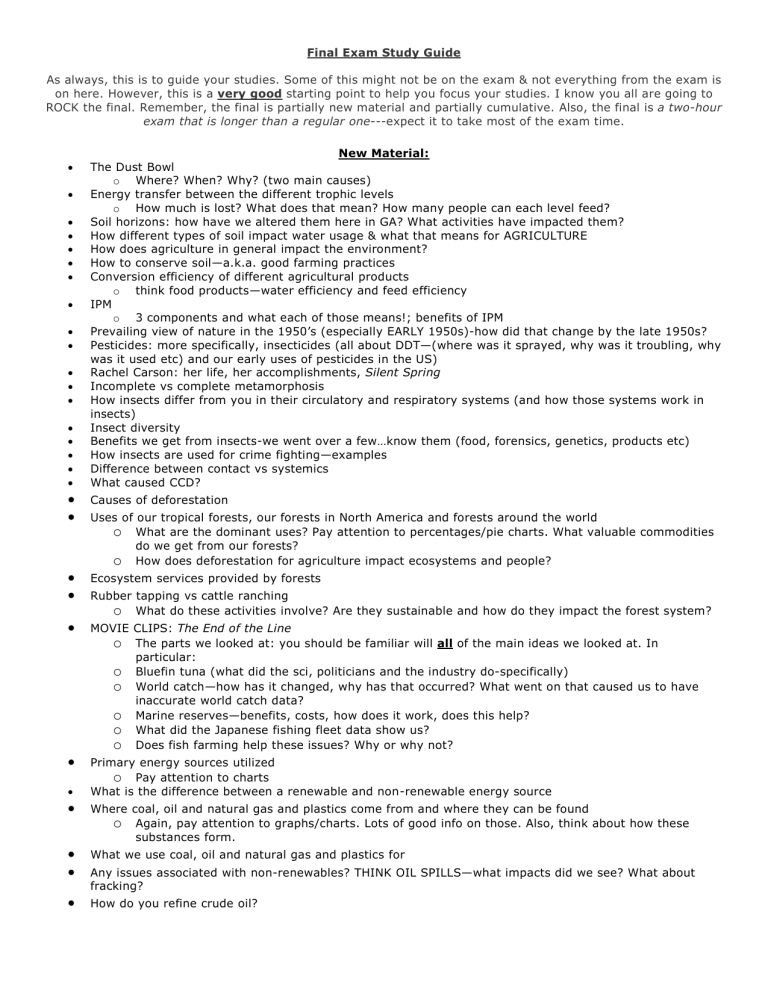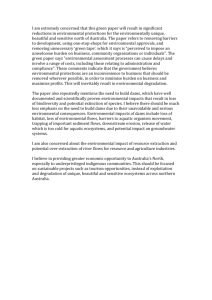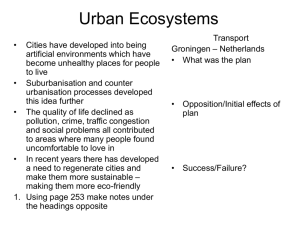
Final Exam Study Guide As always, this is to guide your studies. Some of this might not be on the exam & not everything from the exam is on here. However, this is a very good starting point to help you focus your studies. I know you all are going to ROCK the final. Remember, the final is partially new material and partially cumulative. Also, the final is a two-hour exam that is longer than a regular one---expect it to take most of the exam time. New Material: The Dust Bowl o Where? When? Why? (two main causes) Energy transfer between the different trophic levels o How much is lost? What does that mean? How many people can each level feed? Soil horizons: how have we altered them here in GA? What activities have impacted them? How different types of soil impact water usage & what that means for AGRICULTURE How does agriculture in general impact the environment? How to conserve soil—a.k.a. good farming practices Conversion efficiency of different agricultural products o think food products—water efficiency and feed efficiency IPM o 3 components and what each of those means!; benefits of IPM Prevailing view of nature in the 1950’s (especially EARLY 1950s)-how did that change by the late 1950s? Pesticides: more specifically, insecticides (all about DDT—(where was it sprayed, why was it troubling, why was it used etc) and our early uses of pesticides in the US) Rachel Carson: her life, her accomplishments, Silent Spring Incomplete vs complete metamorphosis How insects differ from you in their circulatory and respiratory systems (and how those systems work in insects) Insect diversity Benefits we get from insects-we went over a few…know them (food, forensics, genetics, products etc) How insects are used for crime fighting—examples Difference between contact vs systemics What caused CCD? Causes of deforestation Uses of our tropical forests, our forests in North America and forests around the world o What are the dominant uses? Pay attention to percentages/pie charts. What valuable commodities do we get from our forests? o How does deforestation for agriculture impact ecosystems and people? Ecosystem services provided by forests Rubber tapping vs cattle ranching o What do these activities involve? Are they sustainable and how do they impact the forest system? MOVIE CLIPS: The End of the Line o The parts we looked at: you should be familiar will all of the main ideas we looked at. In particular: o Bluefin tuna (what did the sci, politicians and the industry do-specifically) o World catch—how has it changed, why has that occurred? What went on that caused us to have inaccurate world catch data? o Marine reserves—benefits, costs, how does it work, does this help? o What did the Japanese fishing fleet data show us? o Does fish farming help these issues? Why or why not? Primary energy sources utilized o Pay attention to charts What is the difference between a renewable and non-renewable energy source Where coal, oil and natural gas and plastics come from and where they can be found o Again, pay attention to graphs/charts. Lots of good info on those. Also, think about how these substances form. What we use coal, oil and natural gas and plastics for Any issues associated with non-renewables? THINK OIL SPILLS—what impacts did we see? What about fracking? How do you refine crude oil? Renewables: solar, wind, biomass, tidal, geothermal etc. What they are, how they work, if applicable: where in the US are these most effective, advantages/disadvantages, any challenges that renewables in general must be overcome o Make sure you are familiar with all of these. We spent some time on algae. Where can it be grown? What are the benefits? How can it be utilized with a corn ethanol plant? Where we all live (urban vs rural) Breakdown of our trash: what's in our landfills Urban heat island effect-what does that mean/impact? Urban sprawl-what causes it? What were some of the examples we looked at for improving public transportation? How the cost of the automobile is subsidized and externalized How impervious surfaces impact water systems Mountain top removal Arctic National Wildlife Refuge Nuclear power- pros and cons Hydroelectricity-pros, cons, rates of usage etc Endocrine disruptors o What are they? How are you exposed? o How do they harm wildlife and/or people? (think physically or behaviorally) o What are the concerns with them, and how do they relate to environmental justice? What are microplastics? What is the Pacific garbage patch? Cumulative Material: REVIEW OLD STUDY GUIDES! Here are some helpful topics. I might give a few extra tips when we get closer to the exam. What does the term ecosystem service mean? Would you recognize one if you saw it? Invasive species o Explain the invasive species examples that we focused on heavily (Where are they from? How did they get here? What damage/impact do they do?) o How do invasives alter biodiversity? Different types of ethical viewpoints Pre- & post-zygotic barriers Climate change o Explain arctic amplification, sea level rise (what’s causing it and why do we care?) and ocean acidification, why is a few degree change a big deal? o How is the arctic changing from climate change? o What countries produce the most ghg emissions? Continental Drift o Evidence of continental drift Explain carrying capacity (what does it mean and can you go above?), umbrella species, keystone species, density independent vs dependent controls, edge effect How can fertilizer cause a dead zone? Why is fire important in certain ecosystems? How do we alter chemical cycles on the planet (think phosphorous, carbon, nitrogen) Water o o Why do we extract groundwater---what’s our number one use? How can you be more water efficient at your home? How did wolves impact Yellowstone? Do fire retardants help? How do they impact human health? What’s a dead zone? How do impervious surfaces impact rivers? (think in URBAN systems) What’s the definition of sustainability? What is an incentive? What is an externality? What are our population estimates for the coming decades? How does biodiversity help ecosystems resist/recover from change? What’s the difference between a food web and a food chain? Which is more accurate? Dam video: All of it is fair game. However… o In particular, pay special attention to: fish hatcheries and the issues associated with it; why dams lose effectiveness over time; general cultural and environmental issues with dams; do you remember how dams impacted people?; how sediment exited dams like Condit Alternatives to dams Dams: o How do they work? o What are they are used/constructed for? o How many there are in the US? How much energy do they produce? o How do they alter ecosystems?

